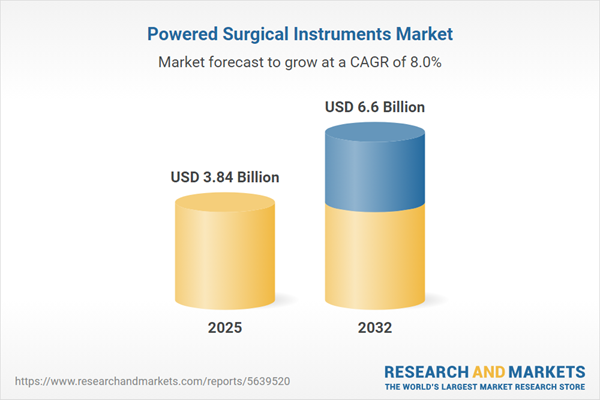Speak directly to the analyst to clarify any post sales queries you may have.
The powered surgical instruments market is undergoing rapid change as hospitals and clinics prioritize precision, performance, and workflow integration. Industry innovators respond with advanced, ergonomically designed tools and connectivity features that redefine standards in surgical care and efficiency.
Market Snapshot: Powered Surgical Instruments Growth Trajectory
The powered surgical instruments market grew from USD 3.55 billion in 2024 to USD 3.84 billion in 2025. Sustained annual expansion at a CAGR of 8.03% is projected, with the market expected to reach USD 6.60 billion by 2032. This growth reflects accelerating demand for devices that combine surgical accuracy, advanced power options, and integrated digital features across global healthcare systems.
Scope & Segmentation
- Product Types: Surgical drills (corded, cordless), surgical reamers (standard, threaded), and surgical saws (oscillating, reciprocating) are tailored to diverse operative requirements and procedural preferences.
- Power Sources: Choices include electric systems known for sustained torque and minimal maintenance, and pneumatic platforms suited for facilities with compressed air resources.
- Procedure Types: Minimally invasive approaches (laparoscopic, robotic-assisted) contrast with traditional open surgery, reflecting varied technical dependencies and clinical objectives.
- Application Areas: Indications span dental (endodontics, implantology), ENT (ear and sinus), maxillofacial, neurosurgical (cranial, spinal), and orthopedic (fracture fixation, joint replacement, spine) interventions.
- End-Users: Key segments include ambulatory surgical centers, hospitals (public, private), and specialty clinics—each with specific procurement and usage needs.
- Distribution Channels: The landscape includes direct sales (online direct, sales force), distributors at national and regional levels, and e-commerce channels.
- Regions Covered: Analysis spans the Americas (United States, Canada, Mexico, Brazil, Colombia, and others), Europe, Middle East & Africa (including the United Kingdom, Germany, GCC countries, South Africa, Nigeria), and Asia-Pacific (China, India, Japan, Australia, South Korea, Southeast Asia).
- Leading Companies: Key industry players include Stryker Corporation, Medtronic plc, Johnson & Johnson, Zimmer Biomet Holdings, Smith & Nephew, B. Braun Melsungen AG, ConMed Corporation, Olympus Corporation, Integra LifeSciences, and MicroAire Surgical Instruments LLC.
Key Takeaways: Strategic Insights for Senior Decision-Makers
- Advances in robotics, artificial intelligence, and battery technology have made surgical power tools more precise and efficient, supporting diverse procedures from neurosurgery to orthopedics.
- Shift to ergonomic designs mitigates surgeon fatigue, while rapid instrument head changes enable seamless procedural transitions and reduced downtime during surgery.
- Hospitals increasingly emphasize integration with digital operating environments and cybersecurity protocols to support data-driven care and device monitoring.
- Modular toolsets and predictive maintenance features provide clear advantages in performance optimization and asset longevity, supporting institutional cost-control strategies.
- Strategic alliances and localized manufacturing enable market leaders to accelerate product roll-outs and adapt to shifting regional regulations and competitive pressures.
Tariff Impact: Navigating US Policy Changes
Recently imposed US tariffs on imported surgical tools are altering global supply chains and pricing dynamics. Manufacturers dependent on foreign components face rising costs, prompting a move toward regional production and tighter supply partnerships. The evolving environment forces procurement teams to diversify sourcing, renegotiate contracts, and balance inventory to minimize disruption. Industry consolidation may intensify as smaller suppliers respond to margin compression, while purchasing organizations focus on total cost of ownership in their evaluations.
Methodology & Data Sources
This report leverages primary research, including in-depth interviews with surgeons, procurement leaders, and engineering experts across regions. Secondary data is drawn from regulatory filings, clinical trials, patents, and academic literature. Competitive trends are mapped through company profiles and M&A records, with findings validated by expert reviews and data triangulation to ensure reliability and actionable insight.
Why This Report Matters
- Guides senior executives to anticipate demand shifts, technology adoption, and regional variations that influence share and profitability.
- Supports strategic investment planning by mapping regulatory, sourcing, and segmentation dynamics for informed market entry and expansion.
- Provides actionable intelligence to optimize resource allocation, streamline procurement, and align product portfolios with evolving hospital and clinic requirements.
Conclusion
The powered surgical instruments market continues to advance, driven by innovation, evolving regulatory policy, and a focus on clinical efficiency. Leaders who adapt to shifting demand and integrate technology stand positioned for sustainable growth in this dynamic sector.
Additional Product Information:
- Purchase of this report includes 1 year online access with quarterly updates.
- This report can be updated on request. Please contact our Customer Experience team using the Ask a Question widget on our website.
Table of Contents
3. Executive Summary
4. Market Overview
7. Cumulative Impact of Artificial Intelligence 2025
Companies Mentioned
The companies profiled in this Powered Surgical Instruments market report include:- Stryker Corporation
- Medtronic plc
- Johnson & Johnson
- Zimmer Biomet Holdings, Inc.
- Smith & Nephew plc
- B. Braun Melsungen AG
- ConMed Corporation
- Olympus Corporation
- Integra LifeSciences Holdings Corporation
- MicroAire Surgical Instruments LLC
Table Information
| Report Attribute | Details |
|---|---|
| No. of Pages | 192 |
| Published | October 2025 |
| Forecast Period | 2025 - 2032 |
| Estimated Market Value ( USD | $ 3.84 Billion |
| Forecasted Market Value ( USD | $ 6.6 Billion |
| Compound Annual Growth Rate | 8.0% |
| Regions Covered | Global |
| No. of Companies Mentioned | 11 |









